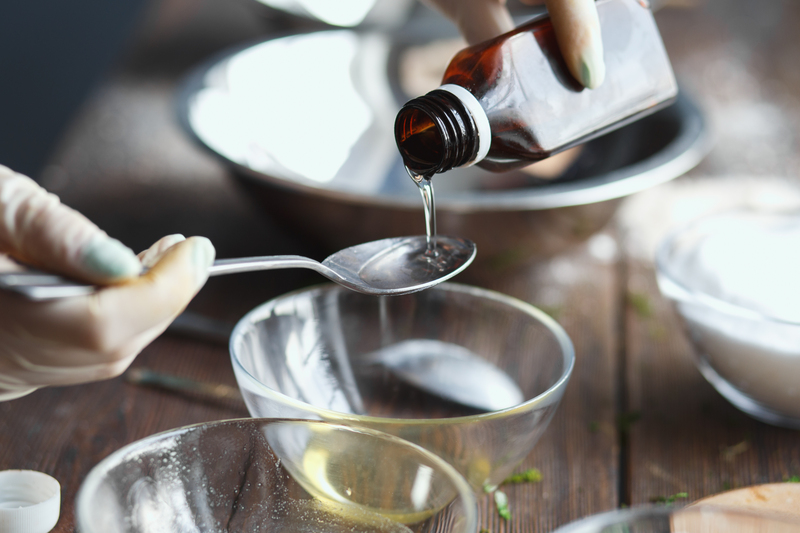Expert Secrets for Keeping Your Bathroom Free of Mold
Posted on 30/08/2025
Expert Secrets for Keeping Your Bathroom Free of Mold
Struggling with persistent mold in your bathroom? You're not alone. Bathrooms are notorious hotspots for mold growth due to their damp and humid environments. Fortunately, there are proven, expert-approved strategies to prevent and eliminate mold for good. In this comprehensive guide, discover the top secrets for a mold-free bathroom, learn about the best prevention methods, and find practical solutions to keep your sanctuary clean and healthy.

Understanding Bathroom Mold: Why It Happens
Mold thrives in environments where moisture and warmth are abundant--making bathrooms an ideal breeding ground. Showers, bathtubs, sinks, and toilets all contribute to excess humidity, and without proper ventilation and cleaning, mold can rapidly take hold.
- High humidity: Steam from showers increases bathroom moisture levels.
- Poor ventilation: Insufficient airflow fails to remove excess damp air.
- Leaky fixtures: Drips and leaks contribute to hidden moisture build-up.
- Porous surfaces: Materials like grout and caulking easily absorb and retain water.
Learning to identify the culprits behind mold infestations is the first crucial step in developing a winning defense.
Expert Tip #1: Master Moisture Control
Controlling moisture is the foundation of any successful bathroom mold prevention strategy. According to leading mold remediation experts, excess moisture is the root cause of nearly all bathroom mold outbreaks.
How to Keep Moisture Levels in Check
- Ventilate Regularly: After using the shower or bath, turn on the exhaust fan for at least 20-30 minutes to remove excess humidity. If you don't have a fan, open a window to promote air flow.
- Wipe Down Wet Surfaces: Dry the walls, mirrors, tiles, and bathtub after use. Pay special attention to grout lines and caulking.
- Use a Dehumidifier: In bathrooms without good natural ventilation, a compact dehumidifier can make a remarkable difference.
- Hang Towels and Mats Properly: Wet towels and bath mats should be hung up to dry outside the bathroom whenever possible.
Regularly reducing moisture ensures that mold has fewer opportunities to develop and spread, which is your strongest line of defense.
Expert Tip #2: Upgrade Your Bathroom Ventilation
Proper ventilation is a game-changer in the quest for a mold-free bathroom. Many older homes lack effective vents or rely solely on windows--which are not always practical.
Ventilation Upgrades That Work
- Install an Exhaust Fan: Choose a model with the appropriate capacity for your bathroom size (measured in CFM--cubic feet per minute). Modern fans with humidity sensors can automatically activate when moisture reaches a certain level.
- Clean and Maintain Existing Fans: Dust and grime can reduce performance. Clean fan covers and blades regularly for efficient operation.
- Leave Doors Ajar: After bathing, leave the door partially open to encourage airflow and speed up drying.
If your bathroom still feels humid or stuffy after these changes, consult with a ventilation specialist for advanced solutions.
Expert Tip #3: Use Mold-Resistant Materials and Products
Strategically choosing surfaces and products can have a major impact on long-term bathroom mold prevention. Modern mold-resistant materials go a long way in deterring fungal growth.
- Select Mold-Resistant Paints: Many top brands now offer bathroom-specific paints containing antimicrobial agents that prevent mold and mildew stains.
- Upgrade Grout and Caulk: Use high-grade, mildew-resistant grout and silicone-based caulk formulated for wet areas.
- Opt for Non-Porous Surfaces: Larger tiles, glass, and synthetic solid surfaces minimize crevices where water can linger.
- Replace Water-Damaged Materials Promptly: If drywall, wood, or ceilings show signs of water damage, replace them to prevent hidden mold growth.
Investing in these upgrades not only keeps your bathroom looking fresh, but also protects against persistent mold problems long-term.
Expert Tip #4: Clean with Mold-Inhibiting Solutions
Consistent, targeted cleaning is essential for maintaining a mold-free bathroom. While regular cleaning is important, using the right products and techniques offers superior protection.
Effective Cleaning Strategies
- Treat Grout and Caulk: Use a mixture of 1 part bleach to 10 parts water (or a commercial mold remover) to scrub these vulnerable areas every few weeks.
- Spray Bathroom Surfaces: After showers, mist tiles, glass, and corners with an anti-mold daily shower spray to deter new growth.
- Remove Soap Scum: Mold feeds on soap residue, so clean soap dishes, walls, and accessories frequently.
- Natural Alternatives: White vinegar, hydrogen peroxide, and baking soda can be used as safer, eco-friendly mold combating agents.
Pro Tip: Always wear gloves and ensure good ventilation when cleaning with chemical agents.
Expert Tip #5: Fix Leaks Immediately
Even minor plumbing leaks provide a constant source of moisture for mold to thrive. Many cases of recurring mold are traced back to leaks under toilets, sinks, or behind walls.
- Check for Drips: Inspect under sinks, around the base of toilets, and along shower lines frequently.
- Seal Cracks: Repair missing or cracking grout and caulk promptly to prevent water infiltration.
- Monitor Water Bills: An unexpected spike in water usage may signal a hidden leak.
- Schedule Annual Plumbing Inspections: A professional plumber can spot and fix issues before they become major problems.
Dealing with leaks swiftly is vital for maintaining a mold-free bathroom environment.
Expert Tip #6: Declutter to Reduce Hidden Mold Hotspots
Excess clutter in the bathroom--such as unused bottles, sponges, and decor--can obstruct airflow and harbor mold in unseen areas.
- Limit Products: Only keep what you use daily, and avoid storing items on shower floors or ledges.
- Launder Fabrics Regularly: Wash and dry shower curtains, liners, towels, and bath mats frequently.
- Elevate Accessories: Use shelves and hooks for storage, keeping items off wet surfaces.
Reducing clutter makes it easier to spot early signs of mold and clean every surface thoroughly.
Expert Tip #7: Perform Regular Mold Inspections
Frequent inspections help catch early signs of bathroom mold before they spread. Early intervention is much easier and less costly than full-blown remediation.
- Check Hidden Corners: Look behind toilets, under sinks, inside cabinets, and above the shower for discoloration or musty odors.
- Inspect Ceilings and Vents: Mold often forms on overhead surfaces, especially around fans and vents.
- Use a Flashlight: Shine a bright light along tile grout, corners, and caulking to spot mold colonies early.
If you detect a persistent musty smell or visible mold patch larger than 10 square feet, consider calling a professional mold remediation service.
Proven Natural Remedies to Prevent Bathroom Mold
For those who prefer a green, chemical-free approach to keeping bathrooms mold-free, several effective natural remedies can be used for daily or weekly maintenance:
- Distilled White Vinegar: Pour into a spray bottle and spritz on tiles, glass, and grout. Let it sit for an hour before rinsing (the acetic acid kills mold spores).
- Baking Soda Paste: Mix with water and scrub onto affected areas for a gentle, non-toxic clean.
- Hydrogen Peroxide (3% solution): Spray on hard surfaces to disinfect and kill mold on contact.
- Tea Tree Oil Spray: Add a few drops to water in a spray bottle--it's a strong antifungal agent and leaves a pleasant scent.
Natural solutions are ideal for regular maintenance and households with children or pets. However, stubborn or deep-rooted mold infestations may require commercial products or professional help.
Frequently Asked Questions About Bathroom Mold
What causes stubborn mold despite regular cleaning?
Persistent mold often results from excessive humidity, hidden leaks, or using cleaning products that fail to kill all mold spores. Rethink your cleaning frequency, upgrade ventilation, and inspect for unseen moisture sources.
Is bathroom mold dangerous?
Prolonged exposure to mold spores can cause health problems such as allergies, respiratory issues, headaches, and skin irritation. Immediate action is important for a healthy home environment.
How do I know if I need a professional mold remediation service?
Call a professional if:
- Mold covers more than 10 square feet
- You experience persistent musty odors despite cleaning
- There is significant water damage behind walls or under floors
- Family members develop unexplained allergies or respiratory symptoms
Can I completely mold-proof my bathroom?
While it's impossible to eliminate every last spore, you can dramatically reduce the chance of bathroom mold by following the expert tips outlined in this guide. Proactive prevention and consistent cleaning are your best defense.

Mold-Free Bathroom Maintenance Checklist
To make mold prevention easy and routine, use this handy checklist every month:
- Run your exhaust fan or open windows after every shower or bath
- Dry surfaces, tiles, and mirrors immediately after water use
- Wash or replace shower curtains and bathroom mats
- Clean grout and caulking with a mold-inhibiting solution
- Declutter and remove unused products
- Inspect for leaks or signs of water damage
- Store toiletries on shelves, not on the shower floor or edges
- Perform a full inspection for mold in corners and unseen places
Conclusion: Take Charge of Bathroom Mold Before It Begins
Keeping your bathroom mold-free is an attainable goal when you arm yourself with the right knowledge and tools. By mastering humidity control, upgrading ventilation, cleaning with purpose, and staying vigilant about leaks, you can banish mold infestations for good.
Remember--consistency is key. With these expert secrets, your bathroom will remain a fresh, healthy haven for years to come.
Take action today and enjoy the comfort of a truly mold-free bathroom!





